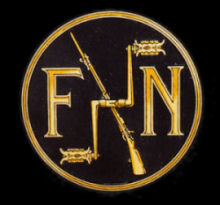



F.N. four-cylinder, having the gear box built close up to the exposed flywheel and clutch
F.N. (139.)
7 h.p.; 52x88 mm. (748 c.c); four-cylinder four-stroke; valves on either side; mechanical lubrication; Amac carburetter; gear-driven magneto; three-speed gear; shaft and bevel drive; Palmer Cord 26in.x3in. tyres.
F.N. (England), Ltd., Kimberley Road, Willesden Lane, London, N.W.8.
Belgium has always been noted for its engineering products, particularly for the excellence of its foundry work, and it is rather disappointing that only one Belgian motor cycle manufacturer is seriously represented in this country. However, the good points of that one make - the F.N. - probably compensate for lack of variety.
From very early days the F.N. four-cylinder has been steadily carving a niche for itself in the heart of the British public, and the latest 7 h.p. model possesses several features as yet unique, but which are considered by many as likely to become almost universal in the future. Modern car practice is followed throughout. Oil level in the sump of the air-cooled four-cylinder engine is kept constant by a mechanical pump possessing a visible indicator. At the end of the massive crankshaft, which is supported on ball bearings, is a proportionally massive flywheel containing a multi-disc clutch. Thence the drive is through a ball-bearing three-speed gear box, by partly enclosed shaft and bevel to the back wheel. Although amply strong and powerful for sidecar work, this model, in view of its specification, is remarkably light, and its even torque and large tyres make it a fascinating and comfortable solo mount.
2½ h.p.; 65x86 mm. (275 c.c); single cylinder four-stroke; side-by-side valves; Amac carburetter; gear-driven magneto; two-speed gear; shaft and bevel drive; Palmer Cord 26in. x 2¼ in. tyres.
When chain drive is being regarded by some as advanced practice if applied to a lightweight, it is well to remember that the 2½ h.p. F.N. has embodied shaft and bevel drive since its inception. A transversely set engine makes this layout not only possible but very neat. The cylinder and top half of the crank case form one casting, the Valves are interchangeable, and the timing gear employs only two pinions, including the magneto drive. All this is illustrative of the great simplicity of the design. As in the "four," an outside flywheel carries a multi-plate clutch (handle-bar controlled); and the two-speed gear box and kick-starter are entirely of F.N. manufacture.
Olympia Show, 1920
The Motor Cycle, December 2nd, 1920.